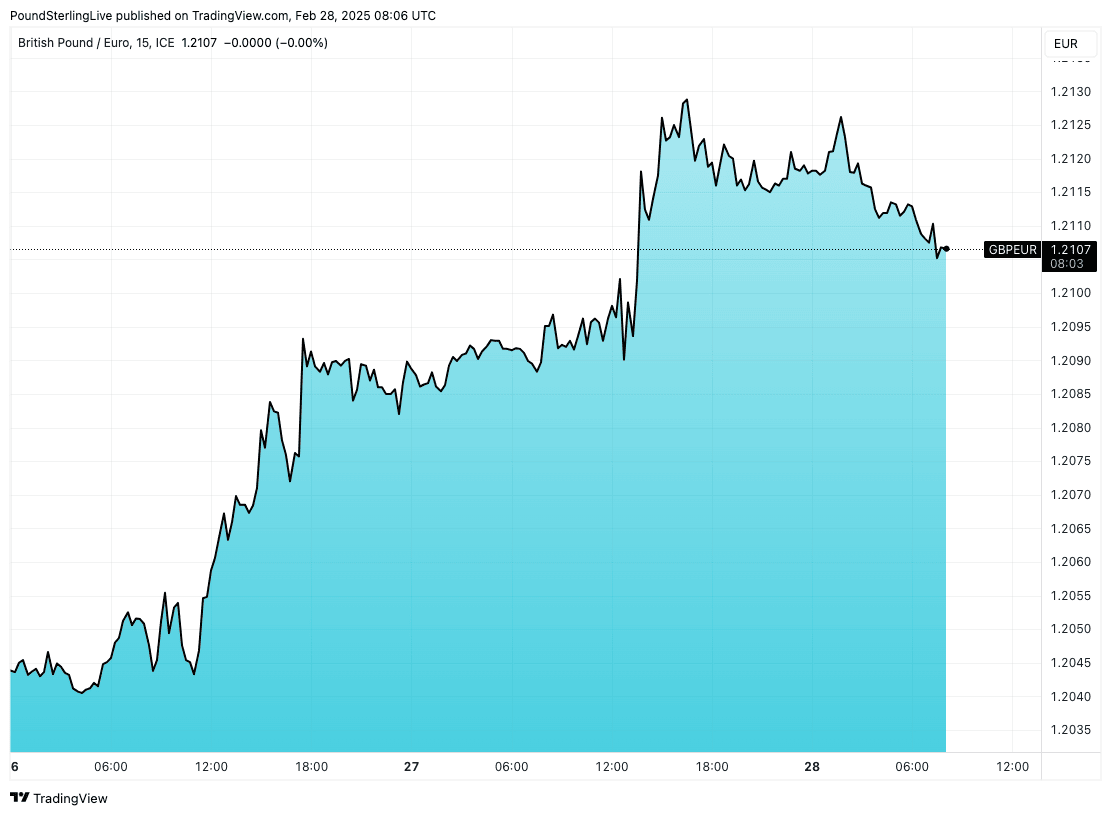
27/02/2025. Washinton D.C., United States. Prime Minister Keir Starmer meets Donald Trump, the President of the United States of America for a bilateral meeting at the White House. Picture by Simon Dawson / No 10 Downing Street.
EU-UK tariff divergence is a real theme for foreign exchange.
The Pound rose to new 2025 highs against the Euro after U.S. President Donald Trump said the U.S. would work towards a free trade deal with the UK.
Trump clearly indicated that the UK was not being lined up for tariffs and that a "real trade deal" was likely.
Speaking to the press following a meeting with Prime Minister Keir Starmer in Washington, Trump said:
"I'll tell you that he earned whatever the hell they pay him over there, but he tried... we could very well end up with a real trade deal where the tariffs wouldn’t be necessary. We'll see."
The European Union faces a more difficult path.
Trump said on Wednesday a 25% tariff would be "generally" applied to EU imports because the European Union "was formed to screw the United States."
"We have made a decision and we'll be announcing it very soon. It'll be 25 per cent,” he said during a meeting of his cabinet.
The divergent fortunes of the UK and EU under the Trump epoch are being etched out in the Pound-to-Euro exchange rate, which rose to its highest level since December at 1.2130.
Above: GBPEUR at 15-minute intervals.
"If GBP/EUR closes above €1.21 this week, it will be the highest weekly close in almost three years," says George Vessey, Lead FX Strategist at Convera. "Analysts see the pound as a tariff safe haven, believing the UK is less vulnerable to tariffs than major exporters like the EU."
The prospect of EU tariffs drew closer after Trump started his day by posting on Truth Social that he would proceed with tariffs against Mexico and Canada next week. He also announced a new 10% tariff on Chinese imports.
The move signalled he was adopting a more 'hawkish' stance on trade, meaning the EU will face significant challenges when its turn arrives.
"The Sterling backdrop looks relatively well supported versus the EUR, not least when combined with the fact that the UK looks less exposed than the eurozone to tariff concerns. Given that UK goods trade remains relatively balanced and or Trump appears to have a favourable view of the UK, relative to his antipathy as regards the EU, suggests an extension in the EUR/GBP downtrend," says Jeremy Stretch, Head of G10 FX Strategy at CIBC Capital Markets.
The Pound rose against all peers, apart from the Dollar, following the Canada and Mexico tariff confirmation.
Although the Pound benefited, risks remain. If global equity markets come under sustained selling pressures owing to tariff fears, then the Pound would struggle against the Euro, Dollar, Yen and Franc.
This is because it retains a 'high beta' to risk sentiment, and a major correction would have an impact.
"When sentiment is positive, sterling appreciates; in negative global conditions, it becomes vulnerable," explains Vessey. "Even with tariff avoidance, a global trade slowdown would still negatively impact the UK economy and the pro-cyclical pound."
According to a research note from BNP Paribas, the British Pound faces significant downside risks in the event of a shift to risk-off sentiment in global markets.
The bank identifies Pound Sterling as one of the most vulnerable currencies among G10 peers, driven by structural weaknesses and heightened sensitivity to investor risk appetite.
"Currently, this yields NZD and GBP as most sensitive to risk-off, while the JPY and CHF could outperform in the G10," says Joshua Wilcock, FX Strategist at BNP Paribas.

